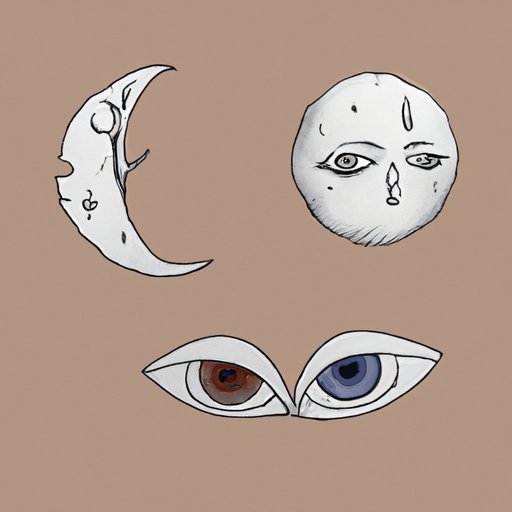
Introduction
The moon has long fascinated humanity, evoking awe, wonder, and inspiration. It has been the subject of myths, poetry, and art throughout history, and it continues to capture our imaginations today. If you’re interested in learning how to draw the moon, you’re in good company. However, despite its seemingly simple shape, the moon can be tricky to draw, particularly if you want to achieve a realistic or creative artistic interpretation. This article will provide you with a step-by-step guide on how to draw the moon, as well as tips, tricks, and creative prompts to help you explore different styles and techniques.
Step-by-step Guide for Drawing the Moon
To draw the moon, you will need basic drawing materials such as paper, pencils, erasers, and perhaps charcoal, pastels, or markers if you want to experiment with different textures and shades. Begin by drawing a circle, which will be the base of the moon. You can use a compass to get a perfect circle or draw it freehand if you prefer. Next, using a soft pencil or charcoal, create the shades and contours of the moon. The key is to observe carefully, making note of the shadows and highlights. Use short, light strokes to create the texture of the moon’s surface. Once you’ve established the basic shape of the moon, you can add more details, such as craters or ridges, using darker pencils or charcoal. You may want to leave some areas lighter to create a sense of depth and contrast.
Understanding the Phases of the Moon
To create a more accurate and realistic moon drawing, it’s important to understand the phases of the moon. The moon goes through eight phases, from the new moon to the full moon and back again. Each of these phases has a distinct appearance and can be used as a reference for your drawing. For example, a full moon is round and bright, while a waning crescent has a thin, curved shape. By observing the moon each night, you can learn to recognize the different phases and incorporate them into your drawing.
Exploring Artistic Options for Drawing the Moon
Drawing the moon doesn’t have to be limited to realism. You can also experiment with different artistic styles and techniques. For example, you can add surreal or abstract interpretations by playing with colors and textures or incorporating symbols or patterns. Another option is to combine the moon into a landscape scene, such as a forest or a beach, to create a mood or atmosphere. The key is to let your imagination guide you and to have fun with your drawing.
Benefits of Drawing the Moon
Aside from the joy and satisfaction of creating art, drawing the moon can also have many benefits. For one, it can be a great way to relax and unwind, allowing you to clear your mind and relieve stress. It can also help you develop hand-eye coordination and increase your spatial awareness. Drawing the moon can also benefit other areas of art and design, such as graphic design or illustration. Plus, it’s a great conversation starter and can help you connect with art lovers or astronomy enthusiasts.
A List of Creative Drawing Prompts about the Moon
If you’re looking for inspiration or challenge, here are a few drawing prompts related to the moon that you can try:
- Draw a lunar landscape with mountains, craters, and valleys – use different shades and textures to create depth
- Create a zentangle pattern of the moon, incorporating shapes and lines
- Draw the moon with a surreal twist, such as adding a face or a scene inside it
- Combine the moon with a landscape of your choice, such as a beach or a forest, to create a mood or atmosphere
- Create an illustration of the moon as part of a science fiction or fantasy story, incorporating characters and settings for a dynamic composition.
Q&A Style Guide for Common Questions about Drawing the Moon
Q: How do I choose the right reference photo for my moon drawing?
A: Look for photos that show high contrast and sharp shadows, which will help you create a realistic look. You can also use multiple photos to create a composite image or to experiment with different angles and perspectives.
Q: How do I create a sense of depth and texture in my moon drawing?
A: Use a range of shades and textures to create depth and contrast. Remember to observe the moon closely to get a sense of its contours, shadows, and highlights. You can also experiment with different mediums, such as charcoal, pastels, or markers, to create a variety of textures and effects.
Conclusion
Drawing the moon can be a fun and rewarding experience, whether you’re aiming for a realistic or creative interpretation. By following the step-by-step guide and experimenting with different styles and techniques, you can develop your skills and create unique and inspiring compositions.




